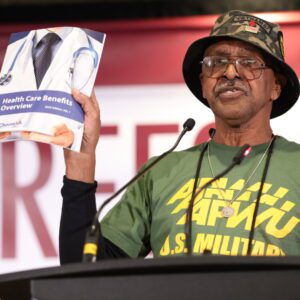December 23, 2014
Recognizing Post-Traumatic Stress Disorder
 This article appeared in the January-February 2015 issue of The American Postal Worker magazine.
This article appeared in the January-February 2015 issue of The American Postal Worker magazine.
Post-Traumatic Stress Disorder (PTSD) is a mental health condition that affects nearly 8 million Americans each year. In fact, 10 percent of our country’s women and 4 percent of its men will develop PTSD in their lifetime. Statistics are higher for hundreds of thousands of members of the Armed Services who experienced military combat. The Department of Veterans’ Affairs (VA) estimates that 31 percent of Vietnam-era veterans, 10 percent of Gulf War veterans, 11 percent of Afghanistan veterans, and 20 percent of Iraq War veterans are afflicted with PTSD.
The condition is triggered by a terrifying ordeal such as assault, natural disaster, accident, abuse, or military combat. It’s not uncommon for people who survive or who witness these types of traumatic events to have short-term stress reactions, but when these responses last for more than a few months; cause great distress; interfere with an individual’s ability to function; disrupt life socially, at home or at work, or damage relationships, PTSD has likely developed. It is the duration and intensity that differentiates PTSD.
Symptoms of PTSD usually begin within three months of a traumatic event, but occasionally emerge years later. Symptoms can also come and go over an extended period of time.
Signs of PTSD can include severe, recurring nightmares, which often result in insomnia, and uncontrollable “intrusive” memories (flashbacks), which are sometimes accompanied by a racing heartbeat or sweating. Re-experiencing symptoms may cause problems in a person’s everyday routine. “Re-experiencing” can start from the person’s own thoughts and feelings. Words, objects, situations, smells and sounds that are reminders of the event, as well as anniversaries, can also trigger re-experiencing.
Some people with PTSD are easily startled by unexpected noises or when surprised. They might have trouble concentrating or they may experience memory problems, including an inability to recall important aspects of the disturbing event. Individuals with PTSD may display a loss of interest in activities and people they’ve enjoyed in the past. They may find it difficult to maintain relationships and may feel hopeless about the future. Practicing social isolation and avoiding places, events, or objects are also strong indicators that someone is suffering from PTSD.
PTSD sufferers will often experience negative changes in their beliefs and feelings, too. They frequently become emotionally numb; have strong feelings of guilt or shame, and generally feel poorly about themselves or others. They often engage in self-destructive or hazardous behavior, such as alcohol and substance abuse, and fast driving. They may also agonize with depression, worry, and anxiety.
People who have PTSD aren’t “crazy,” dangerous, or looking for attention. It is extremely rare for people with PTSD to act out against others. They have no greater propensity to hurt others than individuals without PTSD; but self-directed violent behavior, such as suicide, is more common among veterans with PTSD.
Hyper vigilance is another common trait. People with PTSD are regularly on guard for danger and often have trouble trusting others. They routinely sit with their back to a wall and keep their sight on entrances and exits.
Sadly, many serving in the military fear that seeking treatment will damage their careers or shade the way their commanders perceive them, so they hide their pain. Many veterans think they can tough it out, that their symptoms aren’t severe enough to require medical care, that seeking help is a sign of weakness, or that they deserve to suffer.
Fortunately, as PTSD is becoming more widely discussed and understood, the stigma attached to the condition is dwindling. This, coupled with marked improvements in treatment, is helping members of the Armed Services and veterans make strides towards recovery.
To learn more about treatment options, support groups, and research, visit the National Center for PTSD, at www.ptsd.va.gov and the National Institute of Mental Health (NIMH), at www.nimh.nih.gov.
.


